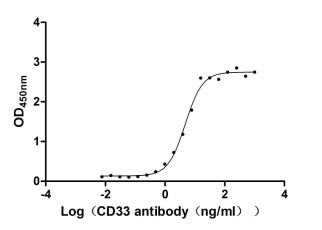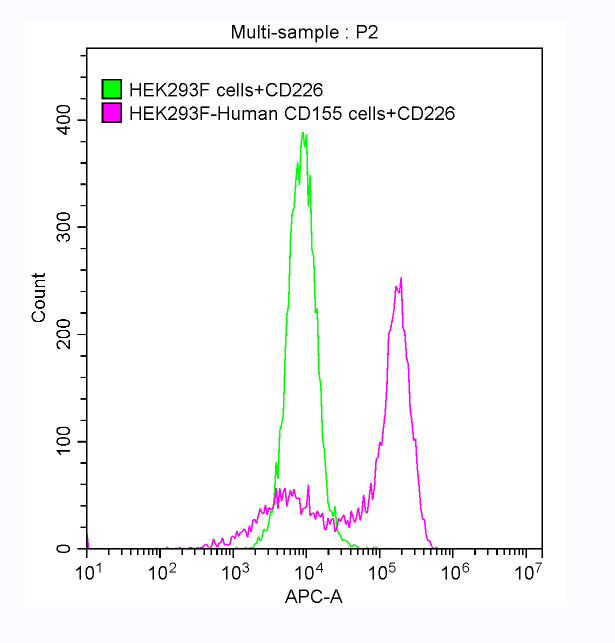Recombinant Mouse NT-3 growth factor receptor (Ntrk3), partial
-
货号:CSB-YP747656MO
-
规格:
-
来源:Yeast
-
其他:
-
货号:CSB-EP747656MO
-
规格:
-
来源:E.coli
-
其他:
-
货号:CSB-EP747656MO-B
-
规格:
-
来源:E.coli
-
共轭:Avi-tag Biotinylated
E. coli biotin ligase (BirA) is highly specific in covalently attaching biotin to the 15 amino acid AviTag peptide. This recombinant protein was biotinylated in vivo by AviTag-BirA technology, which method is BriA catalyzes amide linkage between the biotin and the specific lysine of the AviTag.
-
其他:
-
货号:CSB-BP747656MO
-
规格:
-
来源:Baculovirus
-
其他:
-
货号:CSB-MP747656MO
-
规格:
-
来源:Mammalian cell
-
其他:
产品详情
-
纯度:>85% (SDS-PAGE)
-
基因名:
-
Uniprot No.:
-
别名:Ntrk3; TrkC; NT-3 growth factor receptor; EC 2.7.10.1; GP145-TrkC; Trk-C; Neurotrophic tyrosine kinase receptor type 3; TrkC tyrosine kinase
-
种属:Mus musculus (Mouse)
-
蛋白长度:Partial
-
蛋白标签:Tag type will be determined during the manufacturing process.
The tag type will be determined during production process. If you have specified tag type, please tell us and we will develop the specified tag preferentially. -
产品提供形式:Lyophilized powder
Note: We will preferentially ship the format that we have in stock, however, if you have any special requirement for the format, please remark your requirement when placing the order, we will prepare according to your demand. -
复溶:We recommend that this vial be briefly centrifuged prior to opening to bring the contents to the bottom. Please reconstitute protein in deionized sterile water to a concentration of 0.1-1.0 mg/mL.We recommend to add 5-50% of glycerol (final concentration) and aliquot for long-term storage at -20℃/-80℃. Our default final concentration of glycerol is 50%. Customers could use it as reference.
-
储存条件:Store at -20°C/-80°C upon receipt, aliquoting is necessary for mutiple use. Avoid repeated freeze-thaw cycles.
-
保质期:The shelf life is related to many factors, storage state, buffer ingredients, storage temperature and the stability of the protein itself.
Generally, the shelf life of liquid form is 6 months at -20°C/-80°C. The shelf life of lyophilized form is 12 months at -20°C/-80°C. -
货期:Delivery time may differ from different purchasing way or location, please kindly consult your local distributors for specific delivery time.Note: All of our proteins are default shipped with normal blue ice packs, if you request to ship with dry ice, please communicate with us in advance and extra fees will be charged.
-
注意事项:Repeated freezing and thawing is not recommended. Store working aliquots at 4°C for up to one week.
-
Datasheet :Please contact us to get it.
靶点详情
-
功能:Receptor tyrosine kinase involved in nervous system and probably heart development. Upon binding of its ligand NTF3/neurotrophin-3, NTRK3 autophosphorylates and activates different signaling pathways, including the phosphatidylinositol 3-kinase/AKT and the MAPK pathways, that control cell survival and differentiation.
-
基因功能参考文献:
- TrkC signals to the podocyte actin cytoskeleton to induce migration by phosphorylating WAVE2 Erk dependently. This signaling mechanism may be important for TrkC-mediated cytoskeletal dynamics in podocyte disease. PMID: 29162704
- In a retinitis pigmentosa mouse model, TrkC activity generates phosphorylated Erk, which upregulates glial TNF-alpha, causing selective neuronal death. PMID: 29242588
- our data suggest that Runx3 may play a crucial role in the development of DRGs by regulating the expression of Ntrk3 variants PMID: 26061886
- TrkC expression in E13.5 VCG neurons requires NeuroD and that TrkC expression may be necessary for the normal migration and innervations of those neurons. PMID: 23652629
- The dependence receptor TrkC interacts with Cobra1.TrkC killer fragment shuttles with Cobra1 to the mitochondria to engage apoptosis. PMID: 24034695
- ETV6-SAM domain interface mutations block ETV6-NTRK3-induced cellular transformation PMID: 23798677
- This study demonistrated that NTRK3 plays a role in panic disorder by regulating hippocampus-dependent fear memories. PMID: 24048855
- Despite elimination of TrkC mRNA, no differences in development of kindling were detected between TrkC conditional null and wild type control mice. PMID: 22980123
- Data suggest that postsynaptic TrkC trans interaction with presynaptic PTPsigma generates bidirectional adhesion and recruitment essential for excitatory synapse development and positions these signaling molecules at the center of synaptic pathways. PMID: 21262467
- Dok6 selectively binds to the NPQY motif of TrkC through its phosphotyrosine-binding (PTB) domain in a kinase activity-dependent manner. PMID: 20565848
- Transgenic mice overexpressing TrkC present susceptibility in their response to stress characterized by subtle changes in the HPA axis, marked changes in acute stress-induced brain activation and altered coping strategies. PMID: 19698958
- Data suggest that Runx3 is required for the specification of TrkC-expressing trigeminal ganglion neurons, conveying mechanoreceptive signals from the Merkel cells of the whisker vibrissae to the spinal trigeminal nucleus pars interpolaris. PMID: 20034568
- TrkC is expressed in the mouse cochlear nucleus by around post-natal day 8 and peaks around d30. TrkC immunostain was cytoplasmic. PMID: 19610111
- role of both full-length and truncated isoforms of trkC in Merkel innervation PMID: 12117822
- trkC detected in lung homogenate, on the surface of interstitial macrophages, but not in alveolar macrophages; a previously unknown trafficking signal occurs through neurotrophins in peripheral lung PMID: 12122447
- TrkC autophosphorylation is strongly induced by GM1 ganglioside PMID: 12388556
- TrkC deficient mice show proprioceptive afferent loss through selective neuronal cell death PMID: 12732177
- Increased expression of trkc in the mechanically compressed spinal cord of the spinal hyperostotic mouse (twy/twy). PMID: 12774239
- Esophageal intraganglionic laminar endings share neurotrophin dependence on TrkC with spinal proprioceptors and some cutaneous mechanosensors, in concurrence with their proposed function as vagal mechanosensors crucial for reflex peristalsis. PMID: 14614961
- Preferential expression of BETA2/NeuroD1 and TrkC in posterior lobes explains the earlier start of cell apoptosis and preferential loss of granule cells in the posterior lobes. PMID: 16368089
- TrkC, the NT3 receptor, is present in neural precursors prior to embryonic day E11 until after birth. PMID: 16673387
- Our results demonstrate that the elevated NT3-TrkC tone via overexpression of TrkC in the brain may constitute a molecular mechanism for the expression of anxiety and anxiety. PMID: 16963267
- Thus, our rAd-TrkC vector can transfect NSCs and produce functional TrkC receptors to promote neuronal differentiation of NSCs. PMID: 17007838
- These data indicate that TrkC induces the PI3K-Akt cascade through the activation of c-Src. PMID: 17991742
- higher expression of the orthologous murine Ntrk3 gene was also detected in the hypothalamus of the anx/anx mouse model of anorexia. PMID: 18203754
显示更多
收起更多
-
亚细胞定位:Membrane; Single-pass type I membrane protein.
-
蛋白家族:Protein kinase superfamily, Tyr protein kinase family, Insulin receptor subfamily
-
组织特异性:Isoform 2 expression is restricted to specific areas in adult brain. Isoform 3 transcripts are readily detected early during embryogenesis and are expressed predominantly in adult brain and gonads.
-
数据库链接:
KEGG: mmu:18213
STRING: 10090.ENSMUSP00000037909
UniGene: Mm.119373
Most popular with customers
-
Recombinant Human Myeloid cell surface antigen CD33 (CD33), partial (Active)
Express system: Mammalian cell
Species: Homo sapiens (Human)
-
Recombinant Human CD226 antigen (CD226), partial (Active)
Express system: Mammalian cell
Species: Homo sapiens (Human)
-
Recombinant Human Insulin growth factor-like family member 1 (IGFL1) (Active)
Express system: Mammalian cell
Species: Homo sapiens (Human)
-
Recombinant Macaca fascicularis CD93 molecule (CD93), partial (Active)
Express system: Mammalian cell
Species: Macaca fascicularis (Crab-eating macaque) (Cynomolgus monkey)
-
Recombinant Human Transferrin receptor protein 1 (TFRC), partial (Active)
Express system: Mammalian cell
Species: Homo sapiens (Human)
-
Recombinant Human Interleukin-2 (IL2) (Active)
Express system: Mammalian cell
Species: Homo sapiens (Human)
-
Recombinant Macaca fascicularis C-type lectin domain family 4 member C(CLEC4C), partial (Active)
Express system: Mammalian cell
Species: Macaca fascicularis (Crab-eating macaque) (Cynomolgus monkey)
-
Recombinant Human Transmembrane 4 L6 family member 1(TM4SF1)-VLPs (Active)
Express system: Mammalian cell
Species: Homo sapiens (Human)




















